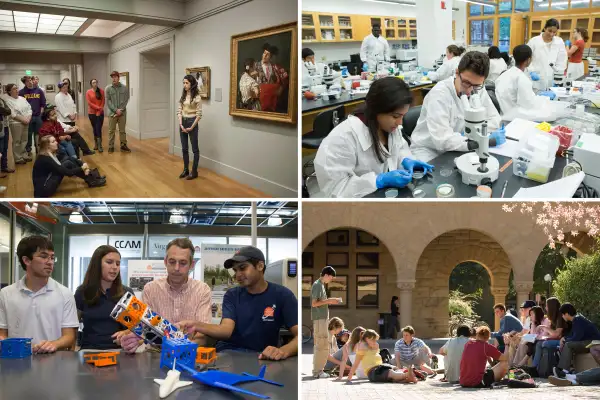These 75 Colleges Promise to Meet 100% of Students' Financial Need

Building a list of potential colleges that will be a good fit financially isn't just a math exercise—it requires some savviness with vocabulary, too. From types of loans to policies around need-based or merit-based aid, the world of college financial aid has a jargon all its own.
Here's a guide to help you understand the financial aid terms that deal with colleges' financial aid policies and need-based aid — plus 75 schools that meet this criteria. To learn more about those schools, check out Money's 2019 Best Colleges ranking.
What Does Meet Full Need Mean?
Colleges that "meet full need" will offer admitted students enough financial aid to cover the difference between a college's price of attendance and a family's ability to pay. The amount a family should be able to pay is determined by financial aid formulas. There's the federal formula, which calculates an "estimated family contribution" based on information reported on the FAFSA. But most colleges with generous financial aid also require a second financial aid form—the CSS Profile—and they use that to guide their institutional financial aid formula. In other words, your family's "demonstrated financial need" may fluctuate, based on how each college counts a family's income and assets.
So, for example, if the financial aid formula says your family can afford to pay $18,000 a year and a college charges $65,000, then a school that meets full need will make sure the remaining $47,000 is covered through a combination of federal, state, and institutional aid.
Most colleges that promise to meet full need will start with federal student loans and work study, and fill in the remaining amount with scholarships, says Matthew Malatesta, vice president for admissions, financial aid and enrollment at Union College in Schenectady, N.Y.
One key detail to reinforce here: You don't determine how needy you are. The FAFSA or college's use of the CSS profile does. Even if you feel your expected contribution is much too high, that's the number that colleges will use to determine your financial need.
Among colleges that meet full need, your out-of-pocket costs can vary widely. Some colleges take the promise one step further and meet need without requiring students or their parents to take out loans. These "no loan" colleges offer financial aid packages with only work study, scholarships, or grants. Other colleges may say they meet full need but don't tally up required student fees into their cost of attendance. And just because a college says it meets full need doesn't mean that it actually accepts many needy students.
What Are Need-Blind and Need-Aware Colleges?
Colleges that are "need blind" admit students without regard to their financial need, while colleges that are "need aware" or "need sensitive" may consider applicants' ability to pay when admitting them.
The terms are somewhat misleading, though. For one, these cases only apply to a minority of colleges — those that are selective enough to reject many qualified applicants. And there are plenty of ways a "need-blind" college can infer an applicant's financial background without reviewing their financial aid materials. Details like parental occupation, home zip code, or school district can hint at a family's socioeconomic status.
There are also very few colleges—about two dozen—that are wealthy enough to truly be need-blind while also meeting full need.
"Everybody else [has] to make sure they don't spend more than the budget allows" Malatesta says.
That means the other colleges that describe themselves as need-blind may be "gapping" students, or admitting them even though there will be a gap between what the college is able to provide in financial aid and what the family can afford to pay.
Other colleges are need-blind but draw in such a wealthy crop of students that they still meet their financial aid budget, Malatesta says.
Need-aware colleges, on the other hand, might only pay attention to ability to pay in certain cases. At Union College, for example, if a student is at the top of the admissions profile, they're going to get in regardless of their level of financial need, Malatesta says.
But for a student on the margin, the college might have to look at how much the student can afford, and what the college has left in its financial aid budget. Union promises to meet full need, and so for every student that is admitted, the college has to make sure it has the money to make it affordable, he says.
If you're trying to better understand the policy at a college you're interested in applying to, first check their financial aid or admissions website. Some colleges, such as Vassar College, are fairly transparent in describing their financial aid practices. If there are not details about the school's policy online, you can ask during tours or via emails to the financial aid office. Try questions like, what percentage of need do you typically meet? and what is the general expected first-year loan within the financial aid packages?
Colleges That Meet 100% of Financial Need
These colleges reported meeting 100% of need for full-time students, with financial aid packages that exclude private loans, unsubsidized federal loans, or parent PLUS loans. Data are self-reported and published by Peterson's.
- Amherst College
- Barnard College
- Bates College
- Babson College*
- Boston College
- Bowdoin College
- Brown University
- Bryn Mawr College
- California Institute of Technology
- Carleton College
- Case Western Reserve University*
- Claremont McKenna College
- Colby College
- Colgate University
- College of the Holy Cross
- Colorado College
- Columbia University
- Connecticut College
- Cornell University
- Dartmouth College
- Davidson College
- Denison University*
- Dickinson College*
- Duke University
- Emory University
- Franklin & Marshall College
- Franklin W. Olin College of Engineering
- Georgetown University
- Grinnell College
- Hamilton College
- Harvard University
- Harvey Mudd College
- Haverford College
- Johns Hopkins University
- Kenyon College
- Lafayette College
- Macalester College
- Marietta College*
- Massachusetts Institute of Technology
- Middlebury College
- Mount Holyoke College
- Northeastern University*
- Oberlin College
- Occidental College
- Pitzer College
- Pomona College
- Princeton University
- Reed College
- Rice University
- Scripps College
- Skidmore College*
- Smith College
- Stanford University
- St. Olaf College*
- Swarthmore College
- Thomas Aquinas College
- Trinity College
- Tufts University*
- Union College
- University of Chicago
- University of North Carolina at Chapel Hill
- University of Notre Dame
- University of Pennsylvania
- University of Richmond
- University of Southern California
- University of Virginia
- Vanderbilt University
- Vassar College
- Wake Forest University
- Washington and Lee University
- Washington University in St. Louis
- Wellesley College
- Wesleyan University
- Williams College
- Yale University
*These 11 colleges report meeting 100% of financial need for freshman, but for not all undergraduates. Many of these colleges still mean above 90% of financial need for undergraduates.

